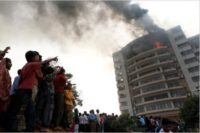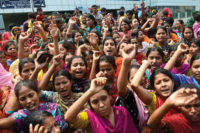For the first time in any supply chain anywhere in the world, Bangladesh’s garment factories are receiving independent, competent inspections, hazards are being identified and corrected, workers and managers are receiving health and safety training, and government and professional OHS resources are being developed.
The challenges impeding more progress are the familiar ones of all global supply chains: delays in remediating hazards caused by limited local resources; lack of political will by the government to promulgate and implement labor laws; and vulnerable workers still facing employer reprisals for exercising their rights.
But the progress since the terrible April 2013 Rana Plaza disaster that killed 1,138 garment workers and injured 2,000 more, is real and sets an example for other supply chains and other producing countries for independent inspections, mandatory hazard correction, public reporting and transparency, and worker participation.
Progress milestones
Inspections of garment export factories are being done by three entities in Bangladesh: the Bangladesh Accord, the Alliance for Bangladesh Worker Safety, and the Bangladesh government with the assistance of the International Labor Organization (ILO). These inspections of fire, electrical and structural safety are being done by competent engineers from Bangladesh and by international engineering firms.
As of June, 2015, more than 2,900 of the 3,500 identified export factories had received initial inspections – 1,291 by the Accord, 1,100 by the national government and ILO, and 613 by the Alliance. Thirty-four factories have been closed with imminent dangers of fires or collapse – preventing another Rana Plaza from occurring. There are four million garment workers in the export garment sector, with more than 80 percent of these being women.
The Accord – a binding agreement between 205 international clothing brands and two international unions and their local affiliates covering 1,500 factories and two million workers – found more than 80,000 safety hazards in its initial inspections. More than 650 Accord factories have been received one or more follow-up inspections, verifying more than 11,000 hazard corrections, and 600 factory Corrective Action Plans are being reviewed for approval.
In June, the ILO announced that the goal of $30 million in compensation for the workers and survivors of the Rana Plaza collapse had been collected, and full payments will be made to 2,860 workers and their families.
The number of factories with unions representing the workforce has increase from 132 in December, 2012 to 453 in May, 2015, according to the ILO. The number of government labor inspectors – both labor law and H&S – has increased from 92 in June 2013 to 270 in February in 2015, according to the ILO, which is providing training and technical assistance to the government inspectors covering a national workforce of 78 million.
There are now three occupational and environmental health centers in Bangladesh: one established by the ILO, a second founded at the Dhaka Community Hospital, and the third established by the Vermont-based Institute for Sustainable Communities.
Health and safety training of garment workers is now being done by ILO, the Accord, and the Alliance (a corporate initiative of 27 U.S. and Canadian clothing companies covering 600 factories and 1.2 million workers). Manager training on safety – and better management and administration – is being done by the ILO’s “Better Work” program in 75 factories, and by many international clothing brands with their supplier factories.
Factories covered by both the Accord and the Alliance will share in a $50 million loan fund from the World Bank’s International Finance Corporation to finance low-cost loans to install new fire and electrical systems, and to improve building structures.
Continuing challenges
While the initial inspections of export garment factories is now approaching 90 percent of the total, there has been a significant delay in implementing hazard corrections in many factories. This is due to a number of factors: the lack of local engineering and safety equipment resources in Bangladesh; disputes between brands and local suppliers over who should pay the costs of hazard corrections; lack of cooperation between factories housed in the same building; and delays in initiating remediation by both brands and suppliers seeking to “relocate” work from buildings with multiple deficiencies.
The government has long delayed promulgation of the regulations for selecting worker members of the joint health and safety committees required since July, 2013 in all factories with more than 50 workers. The Accord, which requires election by workers of their committee representatives, will begin a pilot elections project this fall in some of the 60 factories that have been nominated for the pilot. Other initiatives are awaiting the final rules from the Bangladesh government.
Garment worker health and safety training has been limited to short, general presentations – frequently via videos – that have been complicated by the high worker turnover rates in factories, the low levels of formal education, and high production quotas for workers.
There are continuing problems of employer retaliation against workers, in violation of national law, who have raised health and safety concerns, or who have sought to organize a union in the factory.
Completing the remaining factory inspections is a high priority and the government must verify factories claiming to be closed as well as deal with those which will not cooperate. Progress in enhancing safety needs to be matched by similar improvements in workers’ rights.
Volunteer opportunities
Members of the American Industrial Hygiene Association, American Society of Safety Engineers, and the National Fire Protection Association, and other OHS professionals, have been meeting since Rana Plaza to develop ways that U.S.-based professionals can contribute to building OHS capacity and resources in Bangladesh.
A roster of OHS professionals willing to donate their time and expertise to Bangladeshi organizations, either remotely or on expense-paid trips to Dhaka, has been established and more than 75 OHS professionals in the U.S., Europe and the Mid-East have signed on. A bimonthly list of articles and reports related to OHS issues in Bangladesh has been circulated, and quarterly conference calls to update interested professionals on current and future projects have been held since October, 2014. Additional information on these activities is available from Garrett Brown at garrettdbrown@comcast.net.
A second professional conference and OHS training workshop in Dhaka will be held in November, 2015, sponsored by the Dhaka Community Hospital’s Center on Occupational and Environmental Hazards, with the support of the Harvard School of Public Health and the Collegium Ramazzini in Europe.
Conclusion
The only positive aspect of the Rana Plaza disaster, and the long string of deadly factory fires that preceded it, is the whirlwind of national and international activity focused on workplace health and safety in Bangladesh’s garment industry. Real progress has been made, although it is uneven and not without significant challenges, and, of course, there are other industries (tanneries, shipbreaking and construction) that also desperately need attention in Bangladesh.
These OHS activities are important not only for garment workers in Bangladesh, but are also an important example that could, and should, be followed in other countries, and in other global supply chains such as electronics, toys, sports shoes and equipment. OHS professionals in the U.S .have a rare opportunity to use their skills, expertise and experience to improve working conditions for some of the most vulnerable workers in the world.



